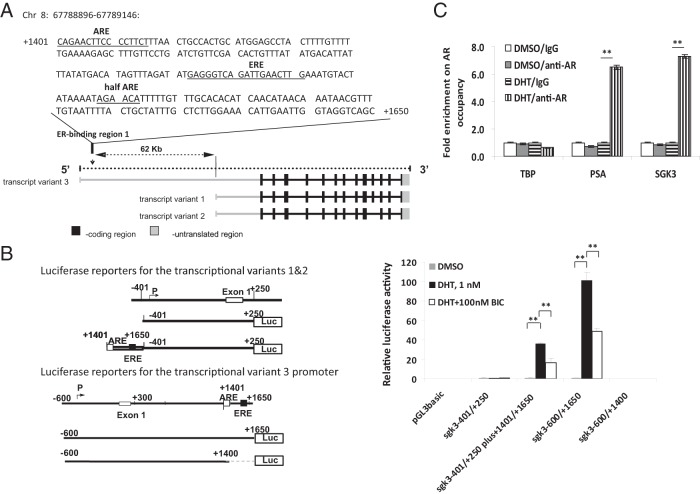Figure 2.
Identification of the AR-binding region at the sgk3 locus. A, Schematic representation of SGK3 transcript variants (lower panel) and the previously identified ER-binding region 1 on sgk3 gene. The ER-binding region 1 contains a putative ARE, an ERE, and a half ARE site (upper panel). B, Left panel, schematic representation of constructs containing sgk3 promoter reporters used in the right panel. The nucleotides are numbered from the transcriptional start site that is assigned as +1. Right panel, LNCaP cells were transfected with the luciferase reporters as indicated and then cultured in the presence or absence of 1 nM DHT and 100 nM bicalutamide (BIC) alone or in combination. Twenty-four hours after transfection, luciferase activity of cell extracts was measured and normalized to protein concentration. Data were expressed as means ± SD from 3 independent experiments. **, P < .01, by the Student t test. C, ChIP-qPCR analysis of the recruitment of AR to the ER-binding region 1 (nt +1401/+1650) in chromatin. LNCaP cells were hormone-stripped for 72 hours and then treated with DMSO or 10 nM DHT for 4 hours. ChIP experiments were carried out using either normal IgG (control) or anti-AR antibody. The precipitated DNAs were used as templates for the qPCR. The primers for each qPCR were described in Materials and Methods. TATA box binding protein (TBP) is a known non-AR target serving as negative control, whereas prostate-specific antigen (PSA) is a known AR target serving as positive control of ChIP-qPCR experiment. **, P < .01, by the Student t test.

